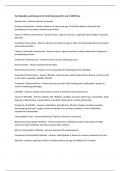Test Questions and Answers for Family Nursing Unit 1 and 2 100% Pass
Amenorrhea - Answers absence of menses
Primary Amenorrrhea - Answers absence of menses by age 15 with the absence of growth and
development of secondary sexual characteristics
Causes of Primary Amenorrhea - Answers stress, vigorous exercise, congenital abnormalities, endocrine
disorders
Secondary Amenorrhea - Answers absence of menses by age 16 with normal development of secondary
sexual characteristics
Causes of Secondary Amenorrhea - Answers stress, vigorous exercise, anxiety, depression, pregnant or
breastfeeding women
Treatment of Amenorrhea - Answers focuses on the underlying cause
Dysmenorrhea - Answers painful menstruation
Primary Dysmenorrhea - Answers not accompanied by underlying uterine pathology
Secondary Dysmenorrhea - Answers fibroids, endometriosis, pelvic inflammatory disease; women in 30s
or 40s; don't respond to NSAIDS; infertile
Treatment of Dysmenorrhea - Answers focuses on pain relief; heating pads, medications, surgery to
remove underlying pathology
Infertility - Answers women who cannot conceive a child after sexual intercourse
Causes of Infertility - Answers obesity, STIs, diabetes, smoking, excessive alcohol use, anovulation, tubal
damage, endometriosis, ovarian failure, low-abset motile sperm, erectile dysfunction
Treatment of Infertility - Answers medications (clomiphene), lifestyle changes (smoking cessation,
decreasing alcohol use), surgery, hormone injections to promote ovulation, in vitro fertilization,
intrauterine insemination
Contraception Types - Answers Behavioral, Barrier, Hormonal, Permanent
Behavioral Contraception Methods - Answers abstinence, withdrawal (coltus interruptus), fertility
awareness-based methods, lactational amenorrhea method
Barrier Contraception Methods - Answers prevents STIs and pregnancy
Permanent Contraception Methods - Answers Tubal ligation or Essure for women; vasectomy for men
Abortion - Answers expulsion of fetus or embryo before the age of viability (22-24 weeks)
, Spontaneous abortions - Answers considered abortion;
Elective abortions - Answers medical abortions, surgical abortions
Nurse actions during abortions - Answers nonjudgmental, unbiased, provide support and advocate for
the client; provide an informed decision
Menopause - Answers absence of menstraul cycle for at least one year; infertile
Average age of menopause - Answers 51
Signs and symtpoms of menopause - Answers hot flashes, disturbed sleep, vaginal dryness, (painful
intercourse) stress incontinence, anxiety, weight gain; likely to get osteoporosis and cardiovascular
disease
Non-pharmacological treatments of hot flashes - Answers environmental treatments (cool environment,
fan, do not eat hot foods, dress in layers)
Hot flashes - Answers can occur up to 30 minutes and last for up to 2 years or 10 years
Who is at increased risk for STIs - Answers teenagers- less access to healthcare, more risky, poverty, do
not want to tell parents they are sexually active
Nursing Management for Teenage patients for STIs - Answers prevent STIS: encourage abstinence, how
to use barrier methods, teach how to prevent the spread, compliance with medication, safe sex and
regualr STI screenings
Vaginitis - Answers inflammation and infection of vagina
Prevention of Vaginitis - Answers avoid tight undergarments, avoid douching, change out wet clothing,
safe sex
Genital Herpes Simplex is spread by - Answers kissing, oral sex, transmitted to babies via birth tract
HSV 1 - Answers cold sores on the mouth
Treatment for HSV 2 - Answers acyclovir, antivirals
Patient first time contracting HSV 2 - Answers will experience more pain and more symptoms; last about
2 weeks
Genital Herpes Simplex - Answers HSV 2
Signs and symptoms of HSV 2 - Answers painful fluid filled vesicular lesions on vulva, vagina, and
perianal area on women and perianal area, urethra, scrotum for men; mucopurulent discharge that
crust over and dry




